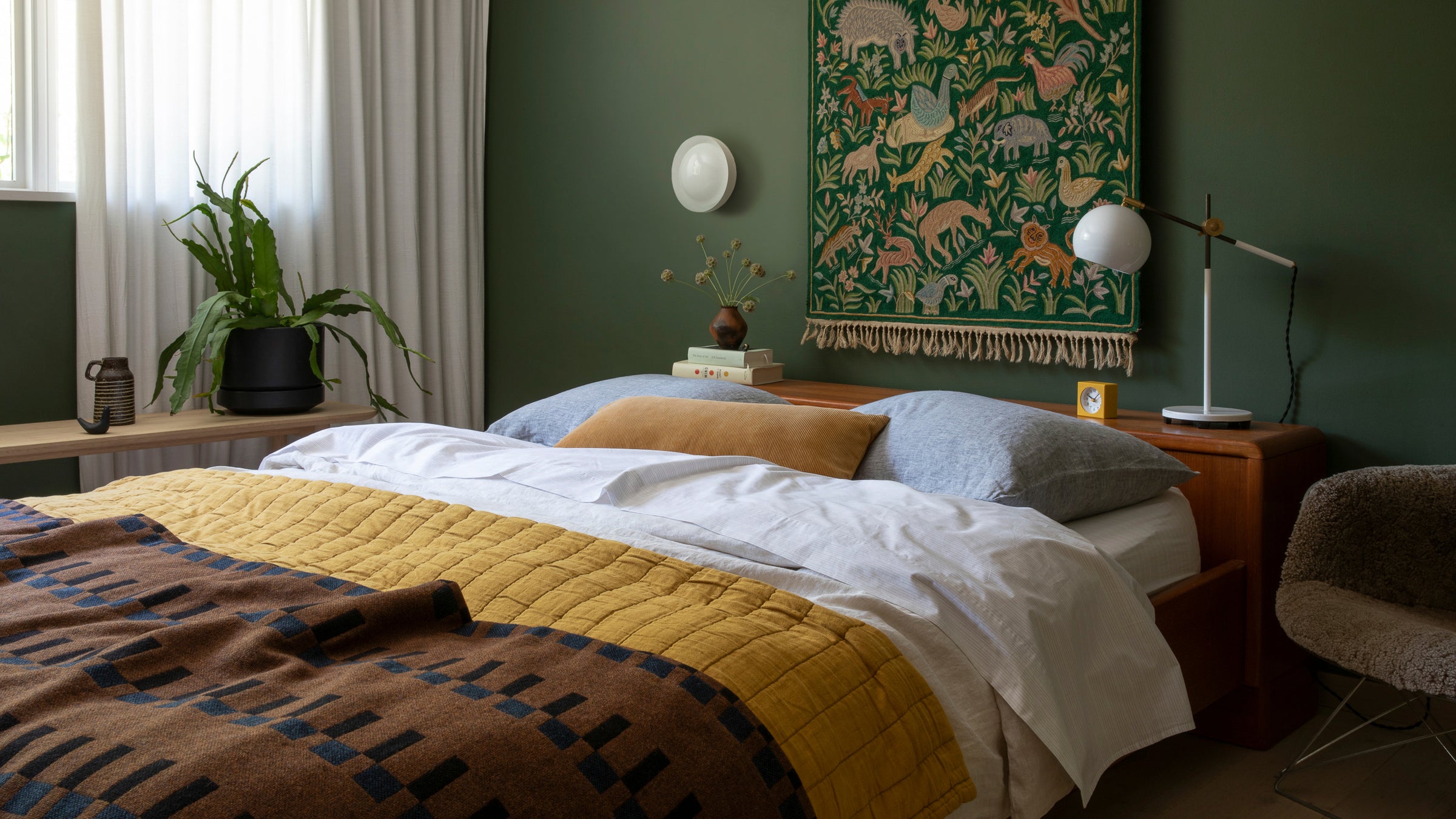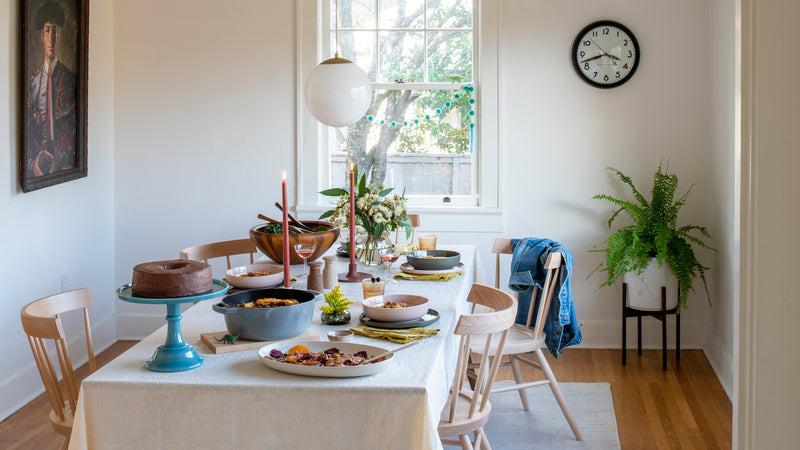Maker Spotlight: Textile Designer Eleanor Pritchard

At our core, Schoolhouse is dedicated to preserving the rich legacy of American manufacturing. And while most of the products we offer are made in the U.S., our quest for enduring design and quality craftsmanship also leads us beyond our borders. One such realm where we’ve ventured internationally is textiles. We’re incredibly grateful to work with skilled artisans from the world over, and today, we wanted to spend some time highlighting a multi-talented individual and the maker behind our Dovetail and Sourdough throw blankets — Eleanor Pritchard.
When we first saw Eleanor’s work, we were instantly struck by the beauty of her blankets and her intuitive approach to color, pattern, and texture. As lifelong fans, we are thrilled to be carrying her designs, and we couldn’t be more excited to share a bit more of her story with you. Below, Eleanor takes us through the world of textiles and gives us a behind-the-scenes look at how the Sourdough and Dovetail throws came to be.

Eleanor in her studio (photo by Anna Huix)
When and how did your love affair with textiles begin?
I came to weaving quite late. After completing my first degree in history, I studied textile at the Chelsea College of Art and Design in my late twenties. But from my earliest childhood, I loved making things and grew up in a very creative home where there was always yarn, fabric, cardboard, and glue on hand. In my teens, I used to scour charity shops for old chintz curtains, which I would make into clothes, so I guess that textiles have always been special to me.
How would you describe the skill of weaving? Could you give us an overview of the process?
I would say that weaving is a combination of color, pattern, texture, and math. There is a lot of counting and planning involved in the process, which is still surprising to me, as I was never good at math in school. Weaving, especially the kind of dobby weave for production that I do, has a lot of parameters, which I find very helpful. Essentially, you work within rules which give structure to the design process. But, within those parameters, the possibilities are limitless.

Eleanor's studio yarn library
When I design a new fabric, I always start with a storyboard of drawings, photographs, postcards, and "flotsam and jetsam," which inspire the mood and the color palette. I am very old-school in my approach and always design long-hand: often using collages to explore concepts. Once I have a pattern and palette I am happy with, I translate it into a weave plan - thinking about how the warp and weft threads will interact to create the cloth. Next, I weave a sample on the old dobby loom in my studio. I have had the loom for almost twenty years, and we have a lot of mileage together! If I like the results, I write up all the weave notes for the mill, so that they can replicate the hand-woven sample identically.
To you, what makes “creating a cloth” magical?
One of the things I love most about weaving is that the pattern and the woven structure are one and the same. The pattern is created as you construct the fabric rather than being applied afterwards. Although you may think of a fabric as being flat, actually, in terms of the threads, one group is always traveling over or under another group, and I love the process of visualizing and working out the structures.
"Despite having woven for so many years, it still seems magical to me that you can construct a fabric from a group of single threads - some sort of alchemy seems to happen along the way."


Initial drawings for the Dovetail Throw
Could you share a bit more about the inspiration and palette behind the Dovetail and Sourdough throw blankets?
The Dovetail blanket takes its name from the woodworking joints - those interlocking corner joints used in traditional carpentry. I originally designed it in two colorways: in tobacco and indigo (which Schoolhouse carries) and in an indigo and granite grey option (which was made for the Tate Gallery to sell alongside the wonderful Anni Albers exhibition a couple of years ago).
The Sourdough blanket is a favorite of mine. It has a homely wholesome feel thanks to the undyed limestone grey yarn. The yarn is spun from a mix of British wool (mainly Suffolk) and a little bit of Jacob and Welsh mountain fleece. We have one on our bed at home, and it brings a lovely sense of calm to the room. Both blankets are woven at a third-generation family-owned mill in Lancashire. I have worked with them for many years, and I really value their skill, expertise, and "can-do" philosophy.

Our interests often influence our work. What hobbies, interests, etc. inspire you?
I am very interested in art and spend a lot of time in galleries and museums. I am fascinated with how color, composition, and texture are explored in different media. I loved the Paula Rego show at the Tate this Autumn – the narrative drive of her work is so strong, but I also really liked the aesthetic and the execution. I am also interested in architecture and often look to the built environment for "found pattern" inspiration – railway tracks, scaffolding, construction sites, and so on.

Do you have any design principles you use as a guide?
The most important thing is to trust your instinct. I never try to follow trends or second-guess what will sell well – I have always found that the designs I love the best are the ones that chime the most with other people.
I also think it is important to consider fabric both in close detail and from a distance. The design and color need to appeal to your eye across a room, but it is also important that more is revealed as you draw near – rewarding a closer look.
Finally, "the proof is always in the pudding." I never put the fabric into production if I have not sampled it first myself. A lot can change along the design journey, and it never pays to take short-cuts.

How do you select color and pattern in your own home?
I enjoy mixing different textures in materials and surfaces. So, I love seeing my blankets against timber or concrete. I love pattern, but I like it used sparingly rather than on every surface. Likewise, with color, I love strong accents against a more neutral background.
Here at Schoolhouse, we talk a lot about heirlooms and how they inspire future nostalgia. What part do you see textiles playing in evoking memories?
Textiles, especially those we use in our everyday lives, often seem to carry a great deal of memory and meaning. I recently inherited a beautiful white and indigo-dyed blanket, which was made in the 1820s for my American great great great great grandmother. It's almost two hundred years old now. Yet, the color and pattern are so strong and fresh. It has been passed down in my family over many generations, and I love to think of all the homes it has graced.
"Textiles, especially those we use in our everyday lives, often seem to carry a great deal of memory and meaning."

Studio photos courtesy of Eleanor Pritchard

